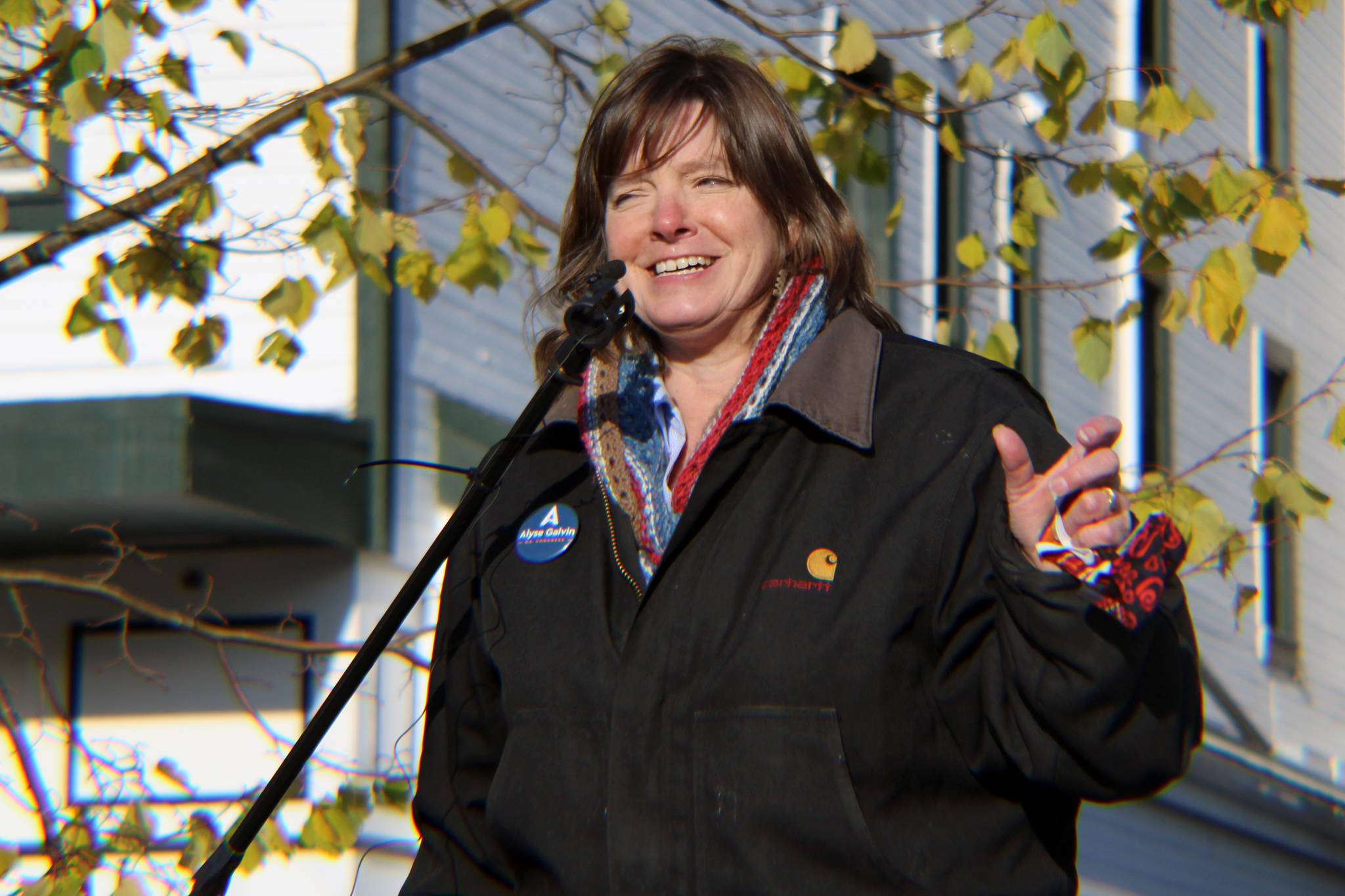Rep. Don Young has held onto his congressional seat since 1973, but in her second stab at unseating Alaska’s single member of the U.S. House of Representatives, Alyse Galvin sees herself already in Washington, D.C.
“We have something to offer to the nation and we need someone in the room while those decisions are being made. And currently, he’s not. I will be,” she said in an interview with the Empire. “He’s actually out in the hallway while I’ll be in the room. He’s out in the hallway shouting that everyone’s a socialist. He’s not helpful in being in the room, explaining what Alaska has to offer.”
Galvin was in Juneau Saturday, holding a drive-in rally on South Franklin after participating in a women’s march from the Alaska State Capitol to Mayor Bill Overstreet Park. She told the Empire that Young had lost his potency as a legislator and could no longer deliver on his promises to Alaska.
“Don Young has been in office for almost 48 years and almost certainly back when he was able to go into a position of power he delivered for Alaska, but times are different,” she said. “As of 12 years ago he no longer could be in any position of power, either because he termed out or because of ethical reasons, violations, he was pushed out.”
As Congress’ longest-serving representative, Young was once chairman of the House Natural Resources and Transportation and Infrastructure Committees. But House Republican rules put six-year limits on chairmanships which means Alaska’s only representative can no longer chair those committees.
[Young and Galvin get a rematch]
Young has also been accused of ethics violations multiple times, including paying $60,000 in fines in 2008 for inappropriate use of campaign funds, the Washington Post reported at the time. Politico reported in 2016 then-House Speaker John Boehner, R-Ohio, forced Young to step down from his post as Chairman of the Natural Resources committee following investigations by the Justice Department over financial issues. Young’s campaign did not immediately respond to a message seeking comment.
“Lots of promises and not any delivery,” Galvin said.
In office, Galvin said she’ll join the bipartisan Problem Solvers Caucus, which is equally divided between Republicans and Democrats according to its website. Galvin is running as an independent, but she’s earned the support of the Alaska Democratic Party and appeared on that party’s primary election ballot. Earlier this year Galvin sued the state for what she claimed was a misrepresentation of her party affiliation by listing her solely as the Democratic candidate and not as non-partisan but the Alaska Supreme Court ruled against her in September. She accused Young of being a party “hack” and said she would not be part of a political machine.
“It’s critical that we make good decisions that are inclusive of Alaskans we need that voice there helping because we’ve got national agenda on the Republican and Democratic side which really aren’t best for Alaska,” she said.
Her main goal, she said, was getting Alaskans back to work in well-paying jobs. The economic recovery from the coronavirus pandemic will profoundly affect the state, Galvin said, and it is critical for someone with a plan for the future to be there when those decisions are being made.
Alaska’s location near the Arctic and boundary waters with adversarial countries like Russia and North Korea give the state unique leverage to negotiate for good infrastructure that will make a long-term difference, she said. Galvin pointed to the use of renewable energies like wind in Kodiak to show how Alaska could shift away from fossil fuels and become more independent.
But while she supports the move away from fossil fuels, Galvin said she understood the importance of the resource industry and believes Alaska should get the most out of what resources it has.
“In large part, every Alaskan knows that we are rich in natural resources, we all know that,” she said. “Between mining, fishing, oil and gas, that is what has lifted us up. Add to that tourism and add to that logistics, What we need is a champion to say, ‘Look, Alaska does it best because we’re the most responsible when we do it,’ and that’s an easy sell because it’s true.”
In 2018, Galvin lost to Young by seven percentage points. But this year Galvin has a significant financial edge over Young. According to the Federal Elections Commission, from Jan. 1, 2019 to Sept. 30, 2020, Galvin’s campaign Alyse for Alaska has raised nearly $4 million while Young has raised only $1.7 million during that time.
Galvin also said one of her priorities is campaign finance reform, limiting the amount of special interest money that can be spent on elections and that her campaign was mostly funded by small donors. As of August, Galvin had received more than $230,000 from national Democrats and political action committees associated with that party, according to watchdog site OpenSecrets. FEC filings show many of Galvin’s donations are through ActBlue, a digital payment platform designed specifically for small donors to contribute to Democratic or affiliated candidates.
But Galvin said she doesn’t see herself as having partisan affiliations.
“I am returning I hope a sense of hope and faith and government because I am really making an effort, working really hard to grow a people-powered campaign that ushers in more honesty, accountability, in a way that I’m hoping will bring Alaskans together, that’s what we do well,” she said. “I’ve been non-partisan for more than 15 years. All of that hyper-partisanship, that’s creating the biggest log jams in getting good decision making. That combined with money.”
• Contact reporter Peter Segall at psegall@juneauempire.com. Follow him on Twitter at @SegallJnuEmpire.

